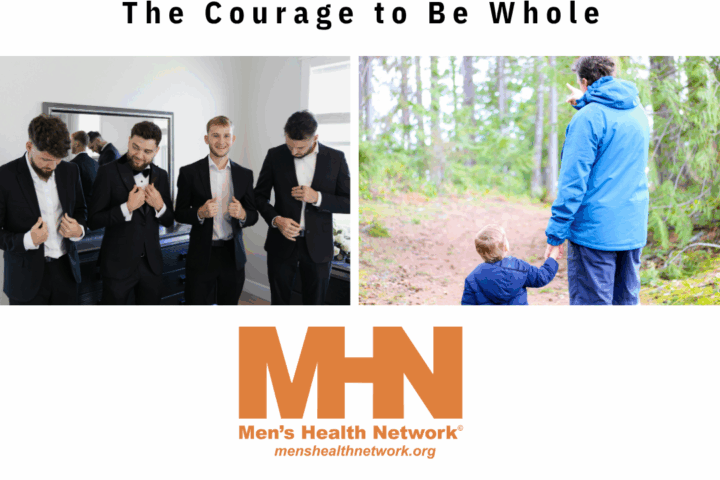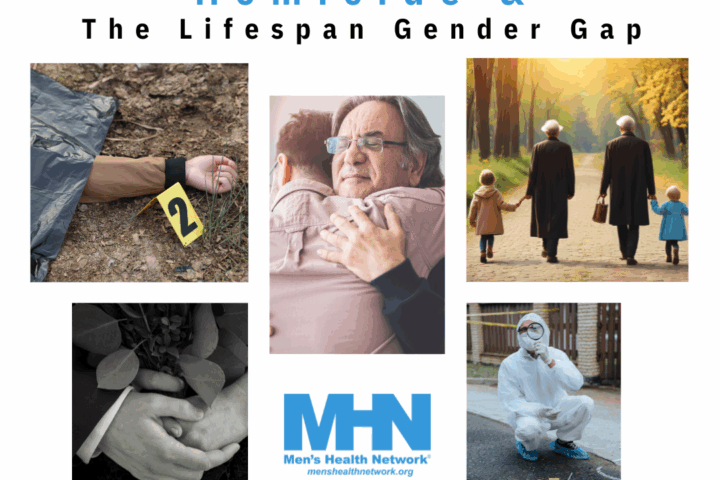Men and boys continue to have a higher death rate in nine of the 10 leading causes of death. Why? To start with, the overall healthcare system is inherently unfriendly to males. And, in some health care situations men tell us they do not feel welcome at all. There are other systemic concerns, including insufficient funding for male health issues and the incredible lack of male-focused outreach and education about health and wellness.
One consequence of this shocking and disturbing reality is the male suicide rate in America. And over the past few months, the Centers for Disease Control (CDC) has released several reports documenting what has become a national disgrace: Males are three to seven times more likely than females to commit suicide, which explains why suicide is the 6th leading cause of death for males—and not among the top 10 for females. A careful reading of the CDC data shows that the suicide rate is highest among middle-aged white men, who accounted for almost 70% of all suicides in 2017
The news gets worse. Recently, CDC highlighted a significant increase in the number of suicides for teens and younger men. Suicides for Millennial males increased almost 300% from the 1950s for the Baby Boomer generation. Most male suicides occur in boys and men who have not been diagnosed as depressed or have a history of mental health issues. We believe that this is, in part, because males access health care far less frequently than do females; there are no clear guidelines on when and how to screen men and boys; health care providers do not properly or regularly screen them for emotional-wellness. For females, however, mental-health screenings are considered so important that they are specifically covered in Well-Woman visits and post-partum care.
Earlier this year, Men’s Health Network (MHN) convened a meeting of 27 internationally recognized experts in health care and mental health to examine the failure to identify mental stress and depression in boys and men. The result was a comprehensive call-to-action that included a blueprint for identifying and helping boys and men in trouble before it is too late. Please download a free copy of this important report at www.MensHealthLibrary.com, Behavioral Aspects of Depression and Anxiety in the American Male.
While the reasons behind the tragic epidemic of male suicides are complex, one thing is certain: it is completely unacceptable in a society that values lives. But in report after report, death after death, the situation becomes more dire and disgraceful every day.
Worse yet, is the seemingly deliberate refusal on the part of some in the scientific community, the media and activists to acknowledge the magnitude of male suicide and one-sidedness of the problem. Too many reports and news stories homogenize data to give often-misleading top-line results and ignore the disparity in male suicide by homogenizing data. This would not be an acceptable practice in any other type of medical reporting.
The solutions? Actually, no single approach will correct the problem but Men’s Health Network recommends that those charged with the health and social welfare of boys and men consider the following as ways to begin: 1) acknowledge the heterogeneity of boys and men and the unique needs of diverse populations; 2) development male-focused screening tools; 3) develop guidelines that recognize the need to regularly and routinely screen boys and men; 4) address the poor reimbursement for behavioral health clinical services and; 5) establish programs to identify, interrupt, triage, and manage mental health issues in boys and men for those in the community who interact with boys and men.
In addition, we urge insurance companies and other payers to include adequately reimbursed Well-Man medical visits similar to the yearly (and free) Well-Woman visits required under the Affordable Care Act (Obamacare). The ACA, as passed by Congress, does not provide for Well-Man visits.
As the oldest non-profit organization whose mission is to reach men, boys, and their families about comprehensive wellness and health matters, Men’s Health Network believes that much more can and must be done by all stakeholders in both the public and private sectors to address the root causes of suicide and prevent them. The humanitarian, emotional, and financial costs to American society of suicide in any demographic are stunning. Treating the growing trend of male suicides as just another sad statistic is no longer acceptable.
We genuinely hope that this new data from the CDC will be the catalyst to bring the topic of men’s health onto the front burner in any discussions of healthcare, whether in Congress, among presidential hopefuls, or in the media. By doing so, we’ll not only save the lives of thousands of men and boys who are dying prematurely, but also improve the lives of the women and girls who love them.
Photo by Gian Reichmuth on Unsplash




